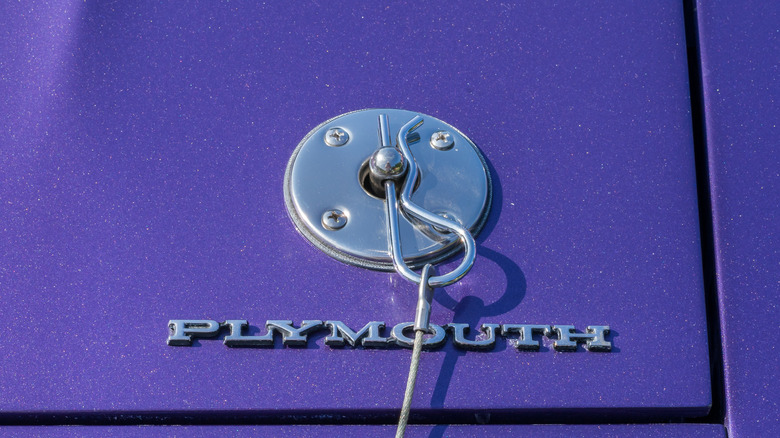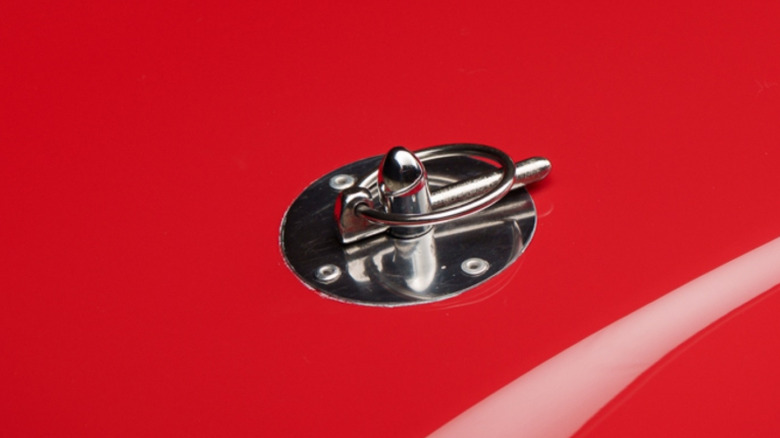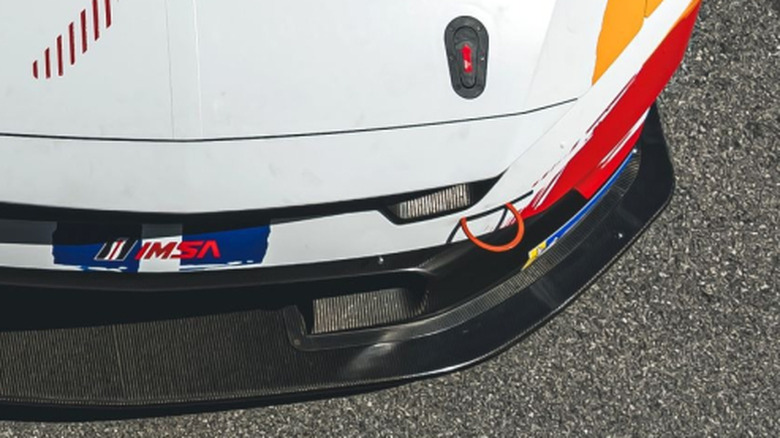Why Do Some Muscle Cars Have Hood Pins? Here's What They're For
If you've ever found yourself at a showcase of classic 1960s muscle cars, you've probably seen a few sporting strange-looking devices on their hoods, known as hood pins. These distinctive gadgets are safety catches designed to keep the hood from flying open when driving at speed. Early hood pins were basic but functional catches on NASCAR stock cars. They started prominently appearing in early super-speedway races before transitioning to street cars, quickly becoming a staple of the muscle-car image. In fact, they were so synonymous with muscle cars that manufacturers like Chrysler even offered vehicles like the Barracuda with factory hood pins.
Their continued use in motor sport is largely a holdover from these times; because they don't weigh much, hood pins add an extra layer of safety for basically no penalty. Bear in mind the sheer amount of force the wind exerts on your hood. Imagine trying to hold down a thin, light sheet of metal with wind hitting it at over 100 mph. That's what would happen if you're racing and a hood latch fails, causing massive amounts of air to enter the engine bay and try to forcibly open the hood. That's why this unassuming but iconic tool has stood the test of time.
But what actually are they? How do they work? And why do so many look so different? Here's a look at the three most common types, how they're used, and what they do, starting with old-school and moving up to more modern designs.
Vintage safety-pin style hood pins
All classic hood pin designs work in roughly the same way, featuring three main elements: the pin, its housing (aka scuff plate) on the hood, and its retaining element (either a torsion pin or a hairpin, also called safety pin). The cable you sometimes see connected to the clip is called a lanyard; it's there so you don't lose the pin when you open the hood. You fix the pin to your vehicle's hard point and drill corresponding holes in the hood, then fit the retainers through holes in the pins. These retainers now securely hold the hood in place.
Hood pins found extensive use for many decades, especially in the '60s and '70s, lending a distinctive look to any car they're on. However, fitting them with lanyards can scuff the paint, so that's something to be aware of, especially in original-condition vehicles (but there are tips and tricks for dealing with paint issues). In general, though, they remain perfectly functional and are absolutely proper to have on even modern serious track cars.
Typically, though, you'd see these on a wide variety of classic muscle cars, sometimes from the factory but generally added-on because they look cool. Not all of these hood pins are functional, either, with imitation kits still sold to this day. Hood-pin designs feature no major variations in function or architecture, though they have evolved over the years with newer materials, the ability to lock, and new retainer designs.
Modern updates to the classic design
Two types of hood pins frequently show up on modern and cool restomod muscle cars: AeroCatch and similar styles, and push-button pins like those made by Quik-Latch. Like the older designs, these use a retainer to keep the hood secure as a safety backup.
You'll see AeroCatch-style pins more often in racing and on fast rally cars, securing body elements in addition to the hood, such as trunks and quick-release modular panels. You push the smaller, fatter button down and pull on the longer, narrower latch to disengage the locking pin. It's a quick, intuitive method for accessing the engine bay in an emergency, and offers a secure means of keeping the hood down since there's no exposed pin to work itself loose. Plus, unlike many hood pins, AeroCatch pins optionally feature locks. The main downside is that they require more specialized work to install because of their shape, and their look might not be to everyone's taste on older cars.
"Quik-Latch" quick-release push-button pins, on the other hand, operate as you'd expect: they're buttons you depress to disengage the pin. Again, they're simple to operate and show up a lot on modern muscle cars and racers. While AeroCatch-style pins are elongated, push-button pins are small, unobtrusive discs, which some people prefer because their design works well with any car. However, it's impossible to tell at a glance if such a pin is open or closed, unlike with the AeroCatch.


